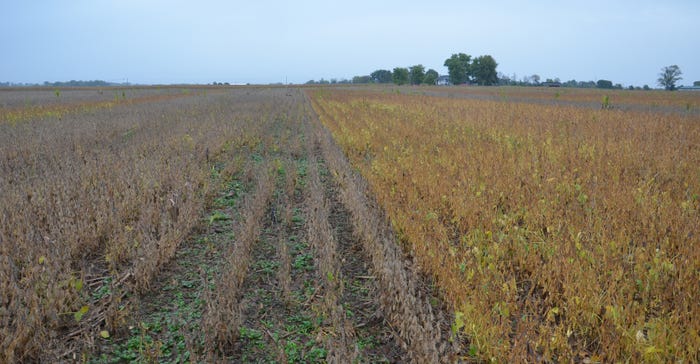
Steve Gauck can’t tell you if the producer who farmed the Soybean Watch ’17 field would have netted a profit by spraying an insecticide during the reproductive phase. Some people apply an insecticide at about the same time they apply a fungicide.
What Gauck, a sales agronomist for Beck’s based near Greensburg, Ind., can say is that when he inspected the field in October, he found signs of insect feeding. The feeding was on the pods, not on the leaves.
Pod feeding by insects can occur literally until harvest, Gauck says. The damage can take various forms, including opening up the pod for infection. In some cases, the soybean nearest where the insect invades may be considerably smaller than a normal-sized bean.
Track insect
Various insects will feed on pods. Bean leaf beetles and stinkbugs are two of the more common insects that may damage pods late in the season, Gauck says.
While you can’t always tell by looking at the damage which insect caused it, you may find other clues. In this case, before leaving the field, Gauck found an individual soybean plant, still green and growing in an area where water damaged the stand, loaded with stinkbug nymphs. “That proves they’re in the field, and makes them the prime candidate for the insect feeding on some pods,” he adds.
Stinkbugs come in two common types in Indiana: the green stinkbug and the brown marmorated stinkbug. To confirm which nymph he found, Gauck pulled out his copy of the Purdue University Corn & Soybean Field Guide, which he carries in his back pocket.
The nymph of the green stinkbug has a dark-colored head and colors on its body. The nymph of the brown stinkbug is all brown and more closely resembles the adult version. Gauck identified the nymphs as green stinkbugs.
Insecticide decisions
“The question we can’t answer is whether or not it would have paid to have applied an insecticide earlier during the soybeans’ reproductive phase,” Gauck says. “There are too many variables which can affect the situation.”
First, at the stage when Gauck was scouting, it wasn’t possible to know how many stinkbugs were present when they were actively feeding on pods. Most economic thresholds for spraying are based on the number of stinkbugs per sweep with an insect net. The thresholds also assume that pods are still green. While Gauck didn’t have trouble finding pods that were affected, he also didn’t classify it as a significant issue. In other words, whether or not the feeding caused yield loss is difficult to prove either way.
Second, it wasn’t possible to determine if the insecticide would have been applied at the right time to control the stinkbugs. Insecticides don’t last long once applied, Gauck notes. Whether the insect was already present or whether it came in later is tough to say.
“What is true is that an insecticide would at least be worth considering next year,” he concludes.
Take a virtual walk through this example via the slideshow below.
About the Author(s)
You May Also Like




